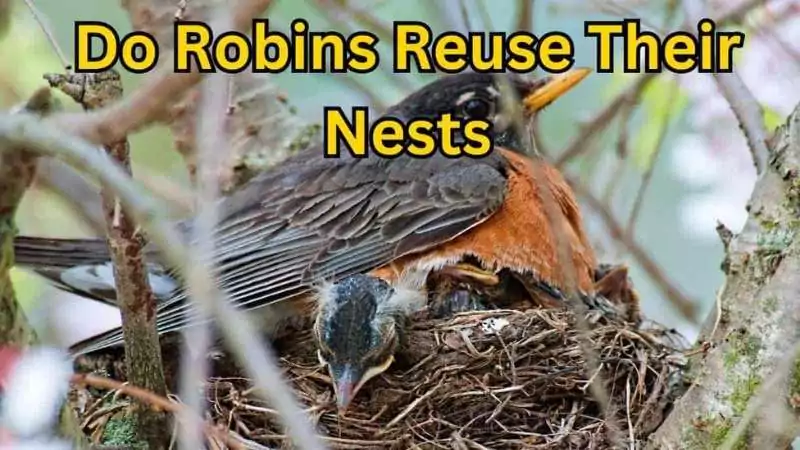Did you know that robins, those cheerful heralds of spring, are also master architects of the avian world? Their approach to home-building is a subject of endless fascination. Here’s a curious fact: while humans might debate the merits of renovating versus moving, robins face a similar dilemma each nesting season.
This opens up a world of questions about these feathered friends. What can we learn from their seasonal quest for the perfect home? This blog will take you through the ins and outs of Robin’s nesting habits, from the choice of site to the final touches on their snug nests. Get ready to see your garden visitors in a whole new light.
The Nesting Behavior of Robins: Architects of the Bird World
Imagine Robin, our bird friend, starting a big project to build her nest, like she’s on a show about fixing up homes. She isn’t grabbing sticks and mud for no reason. She’s got a plan and knows exactly what she wants. Watching her, you’d think she’s an expert builder and designer all in one. Her work is enjoyable and unique to see.
Robin is picky about where she builds her nest. She likes to make sure it’s on something substantial like trees or bushes; sometimes, she even chooses a spot on a building or ledge.
This shows she can adapt well. Building her nest is a careful job where she layers and weaves materials to make a cozy and strong home for her babies. If you want to know more about how Robin and other birds like her build their nests, the Cornell Lab of Ornithology has some excellent information.

Do Robins Reuse Their Nests? Unraveling the Mystery
So, let’s tackle the hot topic: do robins reuse their nests?
Robins generally prefer starting fresh each nesting season rather than reusing old nests. They may recycle materials from previous nests for new constructions, prioritizing safety and nest condition.
Would you move back into a house battered by wind and rain and who knows what else without any upkeep? Probably not. Safety and the condition of the old nest play considerable roles in this decision. An old nest might not be the safest place for Robin’s new eggs.
But here’s where it gets interesting: robins are quite the recyclers. While they might only reuse part of the nest, they’re all about taking those still-good materials to fashion their next cozy abode. It’s like taking the best bits of an old home to make the new one just right.
This bit of Robin’s real estate strategy isn’t just cute; it’s brilliant and efficient. Audubon’s research dives deeper into why robins and other birds start fresh each season, shedding light on the intricacies of their nesting behaviors.
You may also read: Do Birds Reuse Nests
Implications of Nest Reuse for Robin Families
What does the “fresh start each year” approach spell out for the robins? Imagine moving to a new neighborhood yearly; that’s the robin way of life. This constant quest for new nesting sites is more than a quirky trait; it’s a survival strategy.
Robins move around so their babies can find plenty of food and stay safe from dangers like predators. This shows how brutal and intelligent these birds are, like how nature always manages to stay balanced. The Smithsonian’s National Zoo & Conservation Biology Institute has incredible stories about how robins and other birds adjust to changes in their world.
How You Can Help: Becoming a Robin’s Ally
If the idea of lending a wing (so to speak) to Robin and her friends warms your heart, here are a few steps you can take:
- Plant a Variety: Your garden can be a treasure trove of nesting materials. Incorporate a range of plants that provide twigs, leaves, and grasses, making it a one-stop shop for nest-building supplies.
- Install a Birdbath: A reliable water source is like a luxury spa for robins. It’s crucial for adults and their fluffy chicks, especially on those warm summer days.
- Observe and Enjoy: Look for robins carrying construction materials. Spotting one with its beak full of mud can be as amusing as watching a miniature construction worker determined to meet their project deadline.
These simple steps not only support our feathered friends but also bring a bit of nature’s theater to your backyard. Plus, there’s nothing quite like the reward of seeing a robin’s nest come to life in your garden.

People Also Asked
If robins don’t reuse nests, where do the old ones go?
Imagine a tiny abandoned treehouse slowly returning to nature. That’s the fate of most robin nests.
Can I check a robin’s nest for eggs?
It is best to leave this to the professionals – or, in this case, the robins. Disturbing a nest can lead to all sorts of complications.
What’s the best material I can leave out for robin nest building?
Twigs, grass, and small bits of yarn or fabric. Think of it as a DIY craft kit for birds.
How can I tell if a robin has chosen my yard for nesting?
Keep an eye out for robins carrying materials or scouting out cozy nooks. Then, congratulate yourself – a Robin real estate scout has just chosen you.
Wrap Up
To wrap it up, robins are super important to our gardens and nature. They build new nests yearly, showing us how nature is strong and can adjust to changes. This helps us learn and care more about where they live, making our environment healthier.
Helping wildlife, like making our gardens welcoming for robins, make our world a better place. This keeps life around us rich and varied.

